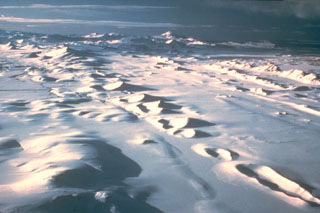Report on Bardarbunga (Iceland) — 25 February-3 March 2015
Smithsonian Institution / US Geological Survey
Weekly Volcanic Activity Report, 25 February-3 March 2015
Managing Editor: Sally Sennert.
Please cite this report as:
Global Volcanism Program, 2015. Report on Bardarbunga (Iceland) (Sennert, S, ed.). Weekly Volcanic Activity Report, 25 February-3 March 2015. Smithsonian Institution and US Geological Survey.
Bardarbunga
Iceland
64.633°N, 17.516°W; summit elev. 2000 m
All times are local (unless otherwise noted)
The Icelandic Met Office reported that the eruption at Bárdarbunga’s Holuhraun eruptive fissure, which began on 31 August 2014, had ended on 27 February; the Aviation Colour Code was lowered to Yellow. During an overflight scientists did not see any incandescence from the vents, although gas emissions persisted. Radar measurements showed that no increase in the extent of the lava field had been detected since mid-February.
Geological Summary. The large central volcano of Bárðarbunga lies beneath the NW part of the Vatnajökull icecap, NW of Grímsvötn volcano, and contains a subglacial 700-m-deep caldera. Related fissure systems include the Veidivötn and Trollagigar fissures, which extend about 100 km SW to near Torfajökull volcano and 50 km NE to near Askja volcano, respectively. Voluminous fissure eruptions, including one at Thjorsarhraun, which produced the largest known Holocene lava flow on Earth with a volume of more than 21 km3, have occurred throughout the Holocene into historical time from the Veidivötn fissure system. The last major eruption of Veidivötn, in 1477, also produced a large tephra deposit. The subglacial Loki-Fögrufjöll volcanic system to the SW is also part of the Bárðarbunga volcanic system and contains two subglacial ridges extending from the largely subglacial Hamarinn central volcano; the Loki ridge trends to the NE and the Fögrufjöll ridge to the SW. Jökulhlaups (glacier-outburst floods) from eruptions at Bárðarbunga potentially affect drainages in all directions.

